The remains of a 90-million-year-old rainforest have been discovered beneath the ice of Antarctica. Now, warmer temperatures are melting glaciers and the meltwater is allowing seeds to begin to germinate. Antarctica is in the grip of one of the world’s fastest climate changes. Its melting ice could contribute to sea level rises of up to 5 metres. Where the ice disappears, it leaves behind barren land. By the end of this century, land the size of a small country could emerge from beneath the ice. Antarctica’s Thwaites Glacier has earned its nickname “Doomsday Glacier” for its potential to flood coastlines around the world if it collapses.
New vegetation has been discovered in Antarctica. Scientists have found 45 square kilometers of green areas on the continent.
Scientists from the University of Edinburgh conducted a study, the results of which were unexpected even for scientists. Studying satellite data, they discovered 45 square kilometers of green zones covering Antarctica. Based on the results of the study, specialists compiled a map of the continent’s vegetation.
It turned out that 80% of vegetation covers the Antarctic Peninsula and nearby islands.
“Although this is only 0.12% of the total area of Antarctica, the map provides valuable data on the distribution of flora in hard-to-reach places,” writes the Gismeteo portal.
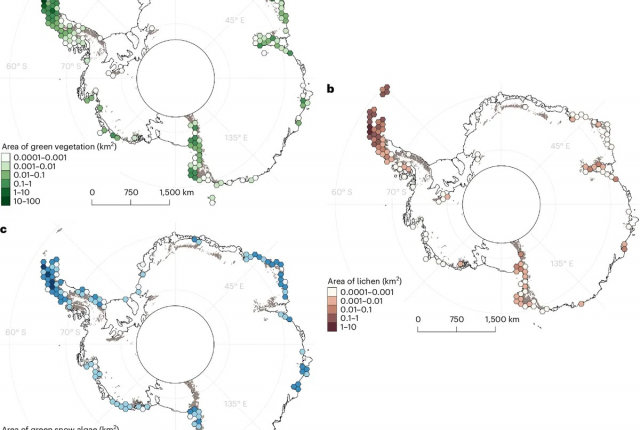
One of the study participants, Charlotte Walshaw, recalled that climate change plays a huge role in the distribution of vegetation. It all starts with the appearance of algae and cyanobacteria on bare soil. They create an environment favorable for the formation of mosses and lichens. Then, in conditions of increased temperature, Antarctic grasses and bryozoans develop.
Scientists were especially wary of the fact that hundreds of new species of flora invaded Antarctica, including even lawn grass. Thus, it is obvious that warming on the continent is leading to its capture by vegetation that is not typical for this territory. Along with the widespread melting of glaciers, this indicates serious changes to which Antarctica is subjected.
The first map of Antarctica’s green spaces has been released.
A tiny seed is stuck between loose gravel and coarse sand. There is nothing alive around it. All it sees is a wall of ice that reaches 20 meters into the sky. It is cold here. Survival is difficult. In winter, it is dark even during the day. In summer, the sun bakes the ground, making it hard and dry for 24 hours. The seed was left here a few years ago by tourists who came to see the wonders of the last remaining corner of wilderness on planet Earth: Antarctica.
New lands in Antarctica are being colonized by pioneer organisms. The first to appear are algae and cyanobacteria, tiny organisms small enough to fit between sand grains. Here, protected from the sun’s scorching rays, the algae live and die, and, as usual, slowly glue sand grains together to create a surface for other organisms to grow on.
Next up are the lichens and mosses. They are only a few centimetres tall, but compared to other life forms on the shores of Antarctica, they look like giants. Once the lichens and mosses have established a home, even larger organisms can emerge, and eventually the plants take hold. Their seeds, if placed in a soft, damp moss bed, multiply and grow.
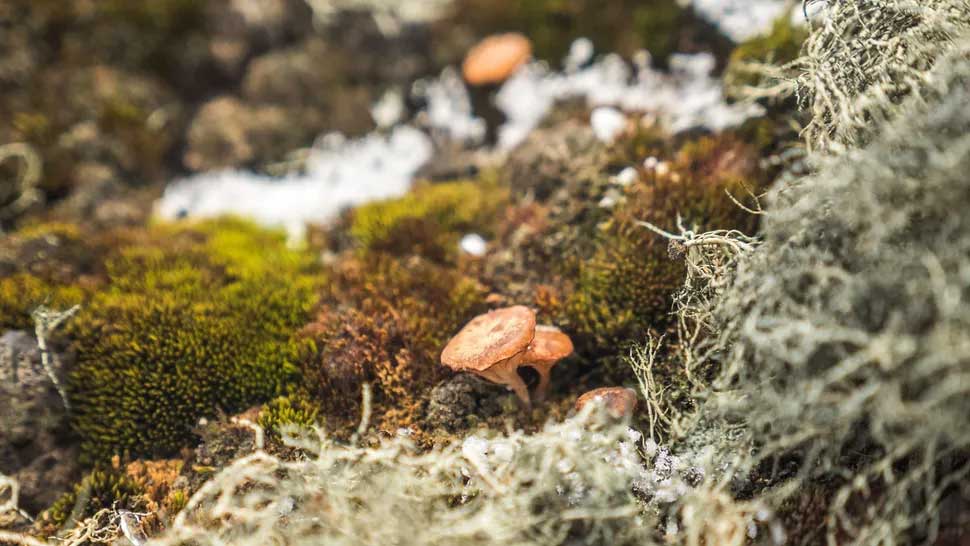
The vegetation of Antarctica consists mainly of lichens and mosses. They have adapted to survive in the harsh conditions of the icy continent. Ruben Earth
Only two species of plants are native to Antarctica. Both disperse their seeds by wind. This makes them independent of animals and insects, which do not need to carry pollen or seeds to another flower or fresh patch of soil. The wind simply blows them there. All these plants need is a piece of moss or lichen to hold on to, so they are not blown away into the cold wilderness of snow and ice.
But this natural sequence of plant emergence has been disrupted as the climate has changed and conditions have become more habitable. More than 100 plant species have already invaded Antarctica. The newcomers are doing well. For example, the fast-growing opportunist Poa annua, a common lawn grass, has spread rapidly across the subantarctic islands from South Georgia to Livingston Island and is now moving south to the Antarctic Peninsula.
Researchers are wondering how much potential there is for new plant species to thrive in Antarctic soils. What will Antarctica look like in 100 years? Could it be green like the tundra landscapes we know from the Arctic?
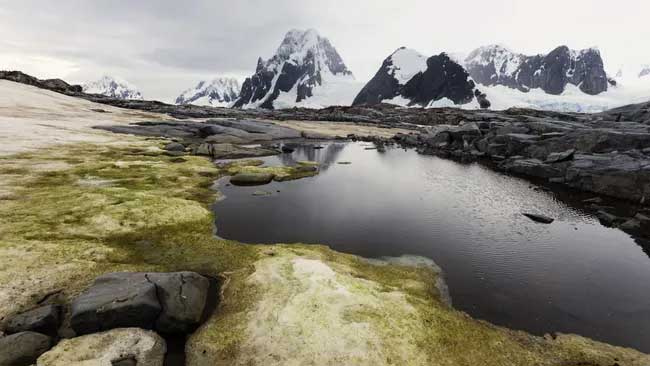
Henrik Sadura
The scientists found 44.2 square kilometers of vegetation overall, mostly on the Antarctic Peninsula and nearby offshore islands. This vegetation area represents just 0.12 percent of Antarctica’s total ice-free area, highlighting how Antarctica remains a frozen continent dominated by snow and ice.
Antarctica’s pristine environment deserves to be protected for its own sake, but it also serves humanity. Climate and weather patterns around the world are determined by the vast ice sheets on the Antarctic continent. Their disappearance would change our planet beyond recognition.
Charlotte Walshaw, from the University of Edinburgh, was the lead scientist on a recent study mapping vegetation in Antarctica. She says these new maps provide key information at a scale that has not been possible in the past. “We can use these maps to look very closely at any large-scale changes in vegetation patterns.”
The vegetation of Antarctica faces some of the harshest living conditions on the planet. Only the hardiest organisms can thrive there, and we don’t yet know what the future holds for them as climate change continues. Now that we know where to look for these plants, we can provide more precise conservation measures to protect their future.
Fossil evidence of an ancient rainforest has recently been discovered in West Antarctica. A thriving temperate rainforest grew in West Antarctica about 90 million years ago, according to a new study, based on newly discovered fossil roots, pollen, and spores. The study was published April 1 in the journal Nature.
The world was different then. In the mid-Cretaceous period (145 to 65 million years ago), dinosaurs roamed the Earth and sea levels were 558 feet (170 meters) higher than they are today. Sea surface temperatures in the tropics reached 95 degrees Fahrenheit (35 degrees Celsius).
This scorching climate allowed tropical forests similar to those seen in New Zealand today to take root in Antarctica, the researchers say.
The remains of a tropical forest were discovered beneath the ice in a sediment core collected from the seafloor near Pine Island Glacier in West Antarctica by a team of international researchers in 2017.
As soon as the team saw the core, they knew there was something unusual. The layer, which formed about 90 million years ago, was a different color. “It was clearly different from the layers above it,” study leader Johann Klages, a geologist at the Alfred Wegener Helmholtz Center for Polar and Marine Research in Bremerhaven, Germany, said in a statement.
Back in the lab, the team placed the core in a CT (computed tomography) scanner. The resulting digital images showed a dense network of roots throughout the soil layer. Ancient pollen, spores, and remains of flowering plants from the Cretaceous period were also found in the dirt.

The operator on the Polarstern vessel controls the MeBo seabed drilling system using remote technology. JP Klages/AWI
By analyzing pollen and spores, study co-author Ulrich Salzmann, a paleoecologist at Northumbria University in England, was able to reconstruct the vegetation and climate of West Antarctica 90 million years ago. “Abundant plant remains indicate that the coast of West Antarctica at that time was a dense, temperate, swampy forest, similar to the forests found in New Zealand today,” Salzmann said in a statement.
Sediment cores show that during the mid-Cretaceous, West Antarctica had a mild climate with average annual air temperatures of about 54 F (12 C), similar to the temperature in Seattle. Summer temperatures were warmer, averaging 66 F (19 C). In rivers and swamps, water could reach 68 F (20 C).
In addition, the researchers found that rainfall at the time was comparable to rainfall in Wales (England) today.
These temperatures are impressively warm, given that Antarctica experienced four months of polar night, meaning it was without life-giving sunlight for a third of each year. But the world was warmer then, in part because atmospheric carbon dioxide levels were high — higher than previously thought, according to sediment core analysis, the researchers say.
“Before our study, the general assumption was that global carbon dioxide concentrations in the Cretaceous were around 1,000 ppm (parts per million),” study co-author Gerrit Lohmann, a climate modeler at the Alfred Wegener Institute, said in a statement. “But in our model experiments, concentration levels of 1,120 to 1,680 ppm were needed to reach the average temperatures of that time in Antarctica.”
The findings show how powerful greenhouse gases like carbon dioxide can cause temperatures to soar, so much so that today’s freezing West Antarctica was once home to a tropical rainforest. What’s more, it shows how important the cooling effects of modern ice sheets are, the researchers say.
Russian scientists have recorded a new record at the Vostok station in Central Antarctica: the temperature there rose to minus 34.2 degrees, which is the maximum value for the winter period in the history of observations, the press service of the Arctic and Antarctic Research Institute reported.
“Scientists from the Arctic and Antarctic Research Institute have recorded the highest winter temperature in the history of regular observations at the coldest point on Earth. At the Vostok station in Central Antarctica on August 6, 2024, the thermometer showed minus 34.2 °C,” the article clarified.
July and August are the coldest months of the year in Central Antarctica; the average long-term temperature in “Vostok” in July is minus 66.6 degrees, and in August it is 67.6 degrees below zero.
The Vostok station is the only year-round inland Russian station in Antarctica. On July 21, 1983, the absolute minimum temperature on the planet was recorded there – a record minus 89.2 degrees.
The sharp temperature jumps over Antarctica in July represent the earliest stratospheric warming ever recorded, according to NASA observations.
Atmospheric scientists closely monitor this region of Earth’s atmosphere, which extends approximately 4 to 31 miles (6 to 50 kilometers) above the Earth’s surface during the Southern Hemisphere winter. Lawrence Coy and Paul Newman, both atmospheric scientists at NASA’s Global Modeling and Assimilation Office (GMAO), create sophisticated models to assimilate and reanalyze data from the global atmosphere and pay close attention to unusual warming events.
Temperatures in the middle stratosphere, about 19 miles (30 km) above the Earth’s surface, are typically around minus 112 degrees Fahrenheit (minus 80 degrees Celsius), but on July 7, temperatures jumped from 27 F (-3 degrees Celsius) to -85 F (-65 degrees Celsius). The jump set a new record for the warmest July temperature ever recorded in the stratosphere above Antarctica.
“The July event was the earliest stratospheric warming ever observed in the 44-year history of the GMAO,” Coy said in a statement.
Temperatures held steady for two weeks before dropping again on July 22. A brief lull was followed by another spike to 31 degrees Fahrenheit (-1 degree Celsius) on August 5.
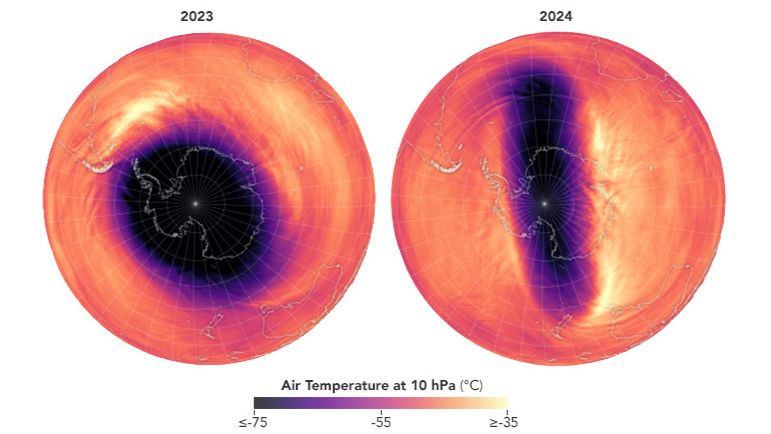
This map shows potential vorticity, a measure of how air masses rotate, in the stratosphere on August 5, 2024. Areas of high potential vorticity appear yellow and have clockwise circulation; areas of low potential vorticity appear purple and have counterclockwise circulation. The polar vortex has stretched and weakened, with the wind flow taking on a peanut-shaped form instead of its usual circular shape. Air temperatures in the middle stratosphere on August 5, 2023 (left) and August 5, 2024 (right). The polar vortex is stretching and temperatures are warmer closer to the pole. NASA GSFC
During winter, the stratosphere is dominated by westerly winds that loop around the South Pole at speeds of about 200 mph (300 km/h). Commonly known as the polar vortex, the flow around the poles is usually symmetrical. However, sometimes the flow is disrupted, and when the winds weaken, the shape of the flow changes. When the polar vortex becomes more elongated, the winds weaken, leading to significant warming in the stratosphere over the Antarctic region.
The Southern Hemisphere’s polar vortex typically remains less active than its Arctic counterpart. “Sudden warm spells happen in Antarctica about once every five years, much less frequently than in the Arctic,” Coy said. That’s likely because the Northern Hemisphere has more land, which can disrupt the wind flow in the troposphere, the lower layer of the atmosphere near the ground, he explained. Large-scale weather systems that develop in the troposphere and move into the stratosphere can influence the polar vortex.
Tropospheric weather in July over Antarctica also tied with July 1991 for fifth place among the warmest July days on record in the region. However, sudden warming of the stratosphere does not necessarily have a clear link to weather, Newman noted.
“Changes in sea surface temperatures and sea ice can disrupt these large-scale weather systems in the troposphere that propagate upward,” Newman said in a statement. “But determining the cause of these systems is really difficult.”
Thwaites Glacier in Antarctica has earned its nickname “Doomsday Glacier” for its potential to flood coastlines around the world if it collapses. It already contributes about 4% to annual sea level rise as it loses ice, and one theory suggests the glacier could soon begin to collapse into the ocean.
Thwaites Glacier drains a huge area of Antarctica’s ice sheet — about 74,000 square miles (192,000 square kilometers), larger than Florida. The bedrock beneath Thwaites Glacier is below sea level and slopes downward toward the land, so the glacier becomes deeper toward the interior of the ice sheet. Once a glacier begins to lose more ice than it gains from new snowfall and begins to retreat, it is very difficult to slow down because of this slope. And Thwaites is already retreating at an accelerating rate as the climate warms.
Thwaites Glacier contains enough ice to raise global sea levels by more than 2 feet (0.65 meters). Once Thwaites begins to destabilize, it will also destabilize neighboring glaciers. So what happens to Thwaites affects the entire West Antarctic Ice Sheet, which affects sea level rise along coastlines around the world.
Sea ice cliff instability is a relatively new concept proposed by scientists in the last decade.
Many glaciers around Antarctica have huge floating extensions called ice shelves that support the glacier and slow its movement into the ocean. As the climate warms, we have seen some of these floating extensions collapse, sometimes very quickly, within weeks or months.
If the Thwaites Ice Shelf were to collapse, it would expose a very tall ice cliff facing the ocean along its 75-mile (120-kilometer) front. Ice can only withstand a limited amount of force, so if the cliff is too tall, it will collapse into the ocean.
Once this happens, a new ice cliff further back will be exposed, and the new cliff will be even higher because it is further from the shore. The theory of marine ice cliff instability suggests that if the cliffs collapse quickly enough, it could cause a domino effect, with increasingly tall ice cliffs collapsing one after another.
However, no one has observed sea ice cliff instability in action. We don’t know if it will happen because a lot depends on how quickly the ice breaks up.
When the sea ice cliff instability theory was first proposed, it used a crude approximation of how ice cliffs might collapse after an ice shelf disappeared.
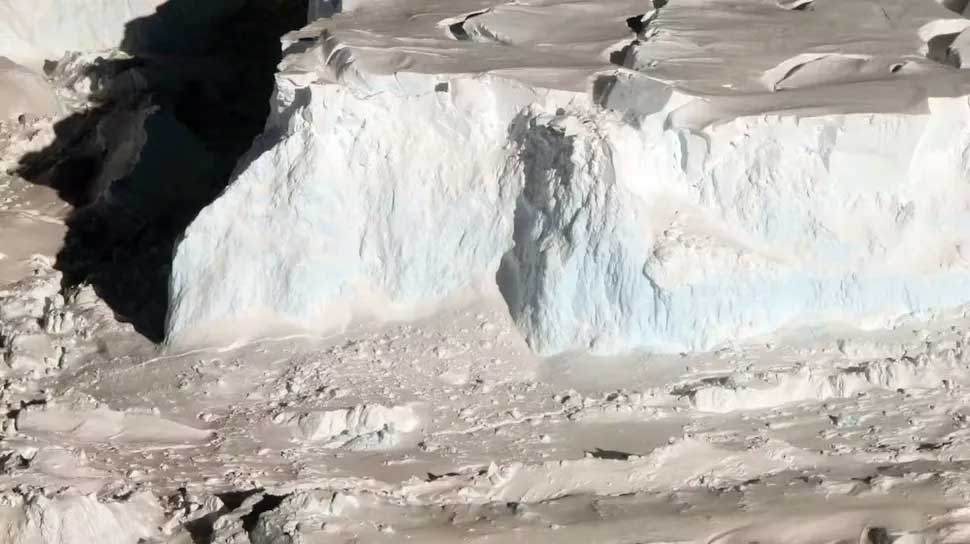
The front of the floating Thwaites Ice Shelf reaches more than 200 feet (60 meters) in places, and gets higher as it gets closer to land. James Jungel/NASA Icebridge 2012
Research has since determined that the ice cliffs will not systematically collapse until the ice reaches a height of about 442 feet (135 meters). Even then, they will collapse more slowly than predicted until they are much higher.
If the entire Thwaites Ice Shelf were to collapse today, its ice front would not retreat rapidly inland only because of the instability of the sea ice cliff. Without the ice shelf, the glacier ice would flow much more rapidly toward the ocean, thinning the glacier front. As a result, the ice cliffs would not be as high.
Thwaites will remain fairly stable until at least 2100. Instability of the sea ice cliff itself would not cause rapid retreat.
The findings call into question some recent estimates of how quickly Thwaites could collapse. This includes a worst-case scenario that the Intergovernmental Panel on Climate Change mentioned in its latest assessment report but labelled as “low probability”.
But sea ice cliff instability is only one mechanism for ice loss. This discovery does not mean Thwaites is stable. There are many processes that make the Antarctic ice sheet unstable, some of which are well understood.
The interaction of ice and oceans accounts for much of the recent ice mass loss. Antarctica is a very cold place, so atmospheric warming has not yet had much of an effect. But warm ocean currents penetrate beneath the ice shelves and thin the ice from below, weakening the ice shelves. When this happens, the ice flows faster because there is less resistance.
Over the past few decades, warm water from the Antarctic Circumpolar Current has entered the sector of the Amundsen Sea where the Thwaites and Pine Island glaciers are located, melting the ice from below.
For more than 30 years, a giant frozen block equivalent in size to Rhode Island lay on the seabed off Antarctica. It finally broke free in 2020 and began moving toward the open ocean last winter.
But a few months into A23a’s journey, observers were stunned by what they saw: the iceberg was spinning in circles.
Using satellite imagery, the British Antarctic Survey has spotted the mega-iceberg rotating near the South Orkney Islands, about 375 miles from the Antarctic Peninsula, since January. According to the survey, A32a maintains a “cold rotation of 15 degrees per day.”
Its movements are likely caused by a phenomenon in fluid mechanics known as a Taylor column. Essentially, it’s a rotating cylinder that forms when there’s an obstruction in the flow. In other words, A23a is trapped in a kind of oceanic vortex.
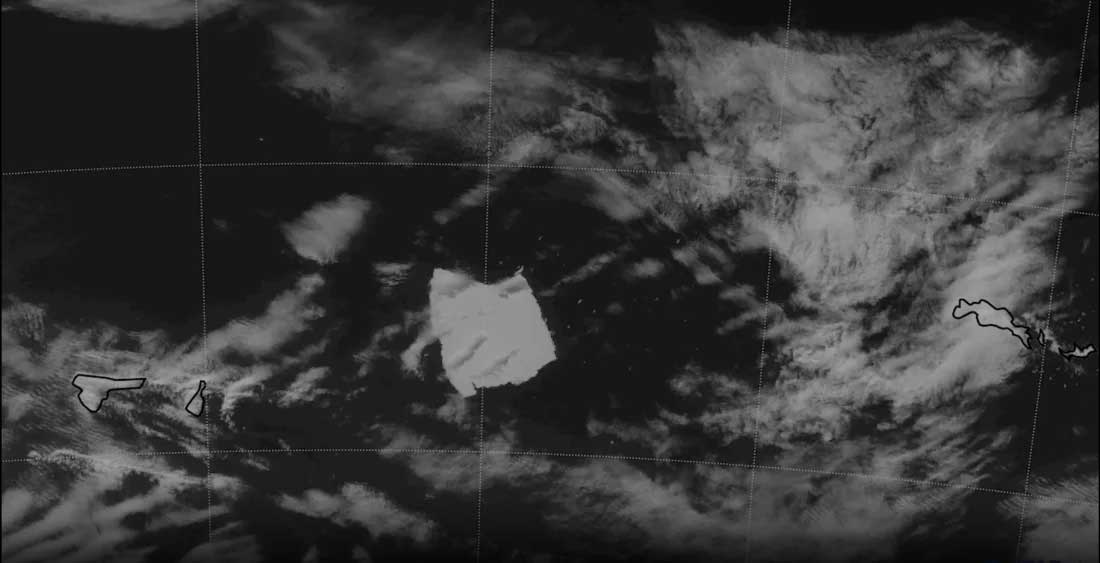
A screenshot of the National Oceanic and Atmospheric Administration’s satellite system tracking iceberg A23a as it drifted in the Weddell Sea off the Antarctic Peninsula in February. NOAA’s Polar Satellite System
University of Wisconsin-Madison professor Till Wagner, who studies the interaction of ice with climate, said he had never seen a real example of the phenomenon on such a scale.
“You know, you can make these Taylor columns quite easily in a rotating tank experiment in your lab. But to see it on a geophysical scale like this is really rare,” he said.
Much remains to be understood about how Taylor columns might affect a monster like A23a. It’s unclear how often Taylor columns form in the ocean, or how often icebergs get caught in them.
In the case of A23a, it’s anyone’s guess how long it will remain swirling in the vortex. The iceberg also melts as it rotates, and Wagner is curious to see how that will affect life in the surrounding ecosystem, such as phytoplankton.
“It would be interesting to see if there is a more active phytoplankton bloom in this area next spring,” he said.
Iceberg A23a was formed in 1986 when the leading edge of the Filchner Ice Shelf broke away from three icebergs. For decades, A23a was stuck to a sandbank in shallow water. In 2020, the bulk of A23a broke free and finally began drifting in the Southern Ocean in November.
It was expected to move north over the next year, reaching warmer waters where it would quickly melt and break apart. Now, A23a’s fate is a little more uncertain.




